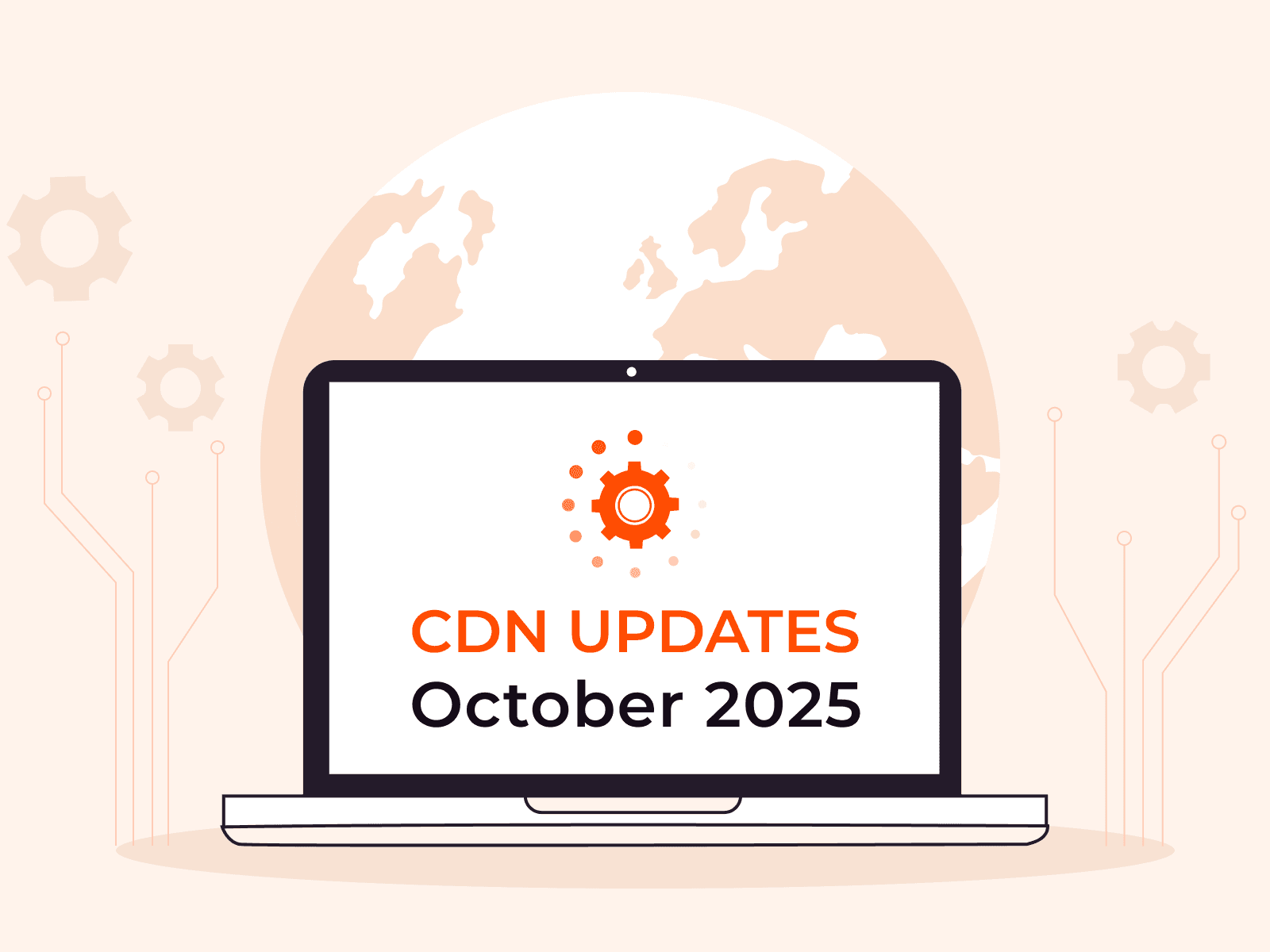How to choose a webinar and video conferencing solution
- March 26, 2021
- 7 min read

For webinars and video conferencing, it is important that the broadcast is of a technically high quality. No matter how interesting your content may be, if the video comes with long delays and glitches, it will ruin the whole experience.
In this article, we’ll tell you what criteria should be met when choosing a streaming platform for webinars and conferences to perfectly suit your tasks.
1. Minimal delays
Imagine: at a webinar, the speaker finishes the topic and asks if there are any questions. The viewers are silent, and the speaker moves on. But then a few questions pop up in the chat. The speaker is interrupted. He’s put off his stride and doesn’t understand why the viewers didn’t ask their questions at the designated time.
But it’s not the viewers who are to blame, it’s the delay. The speaker has already moved on to the next topic, but for the viewers, he’s only now asked if there are questions.
Or you are conducting a video conference, and you have to wait 10 seconds for a response from each participant. So, a short discussion for which you have allocated 20 minutes ends up lasting an hour.
To avoid such situations, choose a platform that provides the lowest latency. For webinars, the delay should be below 4 seconds, and for conferences, no greater than half a second.
Pay attention not only to the delay times the platform claims to provide but also which technologies are used to minimize them. Find out what communication protocols are used.

Low latency protocols:
- Low Latency HLS;
- Chunked CMAF;
- SRT;
- WebRTC.
Make sure to check whether the platform supports at least some of these protocols.
2. Security
Useful and unique content needs good protection. For webinars and video conferencing, it is important that only your users have access to the broadcast and that the video can’t be copied and uploaded to the web.
Protection from illegal viewing
How do you make sure that only those who paid for the webinar can watch it, and only the necessary participants can join your video conference? Be sure to ask how the platform will protect your content in this regard. For example, it could be protected with a PIN code or secure links.
1. Protection with a PIN code. This is pretty straightforward. Users need to enter a code to view or participate in a conference.
In this case, the video itself is transmitted over the network in an encrypted form. Once the video file reaches the recipient, access to the content is provided using a key.
Even if attackers intercept the file, without the key, they will still be unable to decrypt it.
2. Safe links (signed URLs). In this case, your users don’t need to enter anything. Instead, you send everyone a personal secure link. Only the recipient can follow it.
To create a signed URL, the following is added to the regular link:
- a token (an element for authorization);
- the “expires” parameter (a period during which the link will work).
The main element of a secure link is a token. It’s a digital key that the server uses to determine who is making the request and whether they are entitled to access.
When someone follows the link:
- A request is sent to the server along with a token.
- The server receives the data and checks whether the token is valid and whether its owner has the right to gain access.
- If everything is in order, the link opens.
With the help of such links, you not only protect the broadcast, but can also differentiate access levels.
For example, there are two plans for watching your webinar: the cheaper one gives the user the right only to watch and ask questions in the chat, and with the more expensive one, they can download a presentation and additional materials.
Your customers will connect to the webinar using different links. The users of the more expensive plan will have the “Download materials” button, while with the cheaper plan, it will be blocked.
This will give everyone access to the content they paid for.
A platform must provide some form of protection. It’s better when it offers multiple options, so you can choose the most convenient one.
Copy protection
It’s important that no one can copy and distribute your unique content from a webinar or conference. It’s even more important to prevent illegal copying in corporate conferences, so that classified information doesn’t reach competitors.

AES encryption and DRM (Digital Rights Management) provide such protection. This is a set of systems with which you can restrict access to content and establish rules for its use. They are designed specifically to protect copyright on the internet.
Be sure to ask whether the platform supports AES or DRM encryption. If not, it’s best to look for another solution.
3. Load resistance
Take note of how many participants the platform is designed for. Is such a limit enough for you?
Not only is the number of participants that the platform promises to handle important, but also how well it performs under maximum loads.
Load balancing
If you’re hosting a massive webinar with thousands of viewers, the platform needs to have a truly global infrastructure with many nodes. If any of the routes are congested, the system must be able to redirect traffic to other nodes and balance the load.
If your viewers live in different cities and countries, it’s better to choose a platform integrated with a CDN.
A CDN is a set of interconnected servers that take data from the source server and transmit it to end users along the shortest route.

CDN servers are usually located as close as possible to the end users, so the content is broadcast anywhere in the world with minimal delays.
The load in such an event is then evenly distributed. And if one CDN server is overloaded, customers receive the video from the next closest server. This way, your broadcast is available anytime, anywhere.
However, a global infrastructure with a CDN is a solution for large projects with viewers around the world. If you need a platform for small, local events, it’s better to choose a more frugal option.
Adaptive bitrate
Broadcast availability is not always up to you. Users sometimes have a poor connection, so they can’t watch a webinar or fully participate in a conference.
To solve this problem, developers came up with an adaptive bitrate. This technology allows you to adjust the video quality to the bandwidth of each user.
If the participants have a good connection, the stream will be available in 8K. If not, the quality can be reduced to the transmission of audio only.
It’s also possible to adjust the transmission quality throughout the video. For example, if one of your viewers is on the road, the quality will be high in sections where there’s 4G, but will decrease in sections with poor connectivity.

A good platform should definitely support adaptive bitrate.
4. Ease of use
If you’ve purchased an IT solution for webinars and video calls, it should save you the hassle of having to deal with technical issues. The system should be as simple and comprehensible as possible and should require a minimum number of actions before starting.
Easy for you
It’s better if the platform works in a browser, without the need to install additional software.
Check whether video can be integrated into your website. It’s much better to broadcast on your own resource than to redirect customers to another application.
Easy for users
Participants shouldn’t have any connection issues. If the system is complex, you’ll have to explain in detail how to connect to a webinar or conference. And this means more time spent.
5. Prompt problem solving
Another factor that must be considered is the availability of quality technical support. After all, if a failure occurs, it’s important to solve the problem as quickly as possible.
Read reviews about the platform. Find out how quickly the tech specialists respond to problems.
Ideally, support will be available 24/7. This way, webinars and conferences can be held at any time, and you’ll know for sure that help will come if problems suddenly arise.
6. Useful features
The main objective of a streaming platform is to provide high-quality video transmission, without delays or failures. But other features can also be useful.
Important features for webinars and video conferencing:
- Ability to show presentations and share the screen. It’s better to illustrate the material you’re presenting.
- Supported recording and rewinding of live broadcasts. Viewers should be able to rewind the video if they missed an important point. Also, recordings of webinars and conferences can be offered to users for an extra fee.
- Customization. The video player shouldn’t look foreign on your website. It’s important that the appearance of the player can be adjusted to your corporate style.
- Statistics. Needed to analyze how satisfied your users are and what can be improved. It’s useful if the platform can show how many participants there were, what actions they performed, how long they watched the broadcast, and when they started leaving.
Some platforms provide the ability to rebroadcast to social media. This feature is not so relevant for conferences and paid webinars, but if you’re running free events, the ability to rebroadcast will help broaden your audience.
If this feature is relevant to you, find out how easy it will be to enable broadcasting to social networks. Ideally, it should be enough to press a couple of buttons and everything works.
Conclusions
Different webinars and conferences require different solutions. Study the technical features of different platforms carefully to choose the one that is perfect for you. See what features they offer, whether these features are enough for you, and whether some of them are superfluous.
When choosing a platform, be sure to check the availability of options that you think you need. Read reviews about companies and see what their ratings are according to independent sources.
Gcore Streaming Platform
Take a look at our Streaming Platform too. We offer comprehensive solutions for any project. We support broadcasting at all stages, but if necessary, we can integrate individual modules into your own system.
Solutions for webinars and video conferencing
We offer four different modes.
1. Broadcasts of professional filming. An option for large webinars and online events.
- The broadcast is designed for 1,000,000+ viewers.
- The delay is below 4 seconds.
- Rebroadcast to YouTube, Facebook, Twitch, LinkedIn, VKontakte, Odnoklassniki, or Instagram (beta) in one click.
2. Quickly prepared broadcasts. Suitable for medium to small webinars.
- Up to 1,000 viewers.
- The delay is below 1 second.
- A presentation mode and screen sharing.
3. Video conferencing for small groups. This option is suitable for corporate training, online consulting, business meetings, and interactive training.
- Up to 20 participants.
- No viewers. Everyone connected is a participant with a switched-on camera and microphone.
- The delay is below 1 second.
- A presentation mode and screen sharing.
4. Collective viewing. An innovative solution that combines a webinar and a conference. The participants watch the broadcast, but they can also join small groups, communicate via video link, and perform practical tasks.

This kind of interactivity in live broadcasts increases audience engagement. It’s perfect for interactive events or online training.
For example, you can host an online lesson using this solution. The teacher conducts the lesson and gives the audience group assignments from time to time. The participants discuss these assignments with each other and complete them in real time. This way, the effect of “being in the classroom” is created.
In many cases, this can improve the effectiveness of training. For example, such a system will be useful for online foreign language lessons, where communication practice is important.
- This solution is designed for 20 or more people.
- The delay is below 1 second.
- A presentation mode and screen sharing.
Advantages of Gcore Streaming Platform
- Low-latency streaming.
- Protection against illegal viewing and copying using PIN code, secure links, DRM and AES encryption.
- Infrastructure resistant to any load, integrated with its own CDN.
- Adaptive bitrate and support of quality up to 8K.
- Seamless integration of videos into your website or application.
- Works in a browser on all devices, without the need to install additional software.
- Supports 4-hour recording and rewinding of live broadcasts.
- A customizable HTML5 player.
- Detailed statistics.
- Competent 24/7 tech support.
Select the solution that’s right for you. Deliver the best quality video content with no delays or glitches.
Get started with a free consultation from our streaming expert.
Related articles
Subscribe to our newsletter
Get the latest industry trends, exclusive insights, and Gcore updates delivered straight to your inbox.






